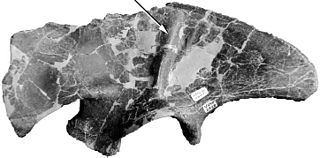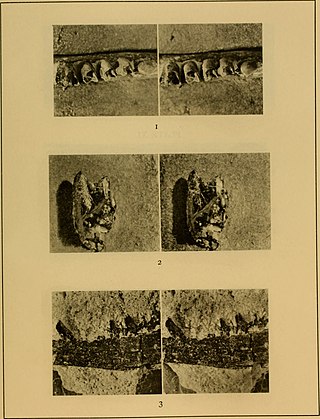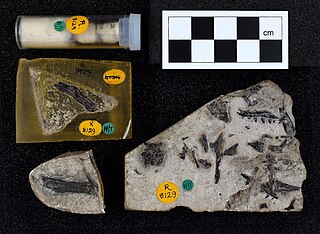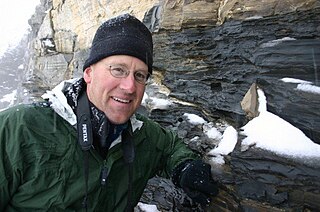
Stokesosaurus is a genus of small, carnivorous early tyrannosauroid theropod dinosaurs from the late Jurassic period of Utah, United States and Guimarota, Portugal.
Rhadinosteus parvus is an extinct species of prehistoric frogs that lived during the Late Jurassic. Fossils of the species were found at the Rainbow Park site in Utah's Dinosaur National Monument, from several slabs of rock which contain multiple partial specimens, from sediments belonging to the Morrison Formation. R. parvus was likely a member of Pipoidea and may have been a member of the family Rhinophrynidae.

The Morrison Formation is a distinctive sequence of Late Jurassic sedimentary rock that is found in the western United States, which has a wide assortment of taxa represented in its fossil record, including dinosaur fossils in North America. It is composed of mudstone, sandstone, siltstone and limestone and is light grey, greenish gray, or red. Most of the fossils occur in the green siltstone beds and lower sandstones, relics of the rivers and floodplains of the Jurassic period.
Enneabatrachus is an extinct genus of prehistoric frogs known from the late Jurassic Morrison Formation of the United States and also the Late Jurassic-Early Cretaceous Ksar Metlili Formation of Morocco. The type species is E. hechti, whose remains have been recovered from stratigraphic zone 5.
Amphidon is an extinct genus of Late Jurassic mammal from the Morrison Formation. It is present in stratigraphic zone five. Two species have been named in the genus: Amphidon superstes and Amphidon aequicrurius, by Simpson in 1925.
Aploconodon is an extinct genus of Late Jurassic mammals belonging to the family Amphidontidae. It contains one species, A. comoensis.

Priacodon is an extinct genus of Late Jurassic eutriconodont mammal from the Alcobaça Formation of Portugal and the Morrison Formation of the midwestern United States. It is present in stratigraphic zones 4–6 of the latter. The genus contains four known species: Priacodon ferox, Priacodon fruitaensis, Priacodon lulli and Priacodon robustus.
Comodon is an extinct genus of Late Jurassic mammal from the Morrison Formation of Wyoming. Fossils of this taxon are present in stratigraphic zone 5.
Triconolestes is an extinct genus of Late Jurassic eutriconodont mammal from the Morrison Formation, present in stratigraphic zones 4. Known from only a single molar, it is a small mammal typically considered an amphilestid. However, it has also been compared to Argentoconodon, which has been considered a volaticothere related to gliding mammals such as Volaticotherium and Ichthyoconodon.
Amblotherium is an extinct genus of Late Jurassic and Early Cretaceous mammal. The type species Amblotherium pusillum is from the Lulworth Formation of southern England, while the referred species Amblotherium gracile is from stratigraphic zones 2, 3 and 5 of the Morrison Formation of the US.

Paurodon is an extinct genus of Late Jurassic mammal from the Morrison Formation of the Western United States.
Tathiodon is an extinct genus of Late Jurassic mammal from the Morrison Formation. Present in stratigraphic zone 5.

Laolestes is an extinct genus of dryolestid mammal. Fossil remains are known from the Morrison Formation, in stratigraphic zones 5 and 6., the Late Jurassic of Portugal, and Early Cretaceous Wadhurst Clay of the United Kingdom.

Dryolestes is an extinct genus of Late Jurassic mammal from the Morrison Formation and the Alcobaça Formation of Portugal. The type species Dryolestes priscus is present in stratigraphic zones 2, 5, and 6.
Euthlastus is an extinct genus of Late Jurassic mammal from the Morrison Formation. Present in stratigraphic zones 5 and 6. It is represented by only five upper molars.
Schillerosaurus was a genus of prehistoric lizard of the Late Jurassic Morrison Formation of Western North America, and is currently the only squamate genus known to be endemic to the Morrison Formation. Described based on a partial skeleton from Dinosaur National Monument by Susan Evans and Dan Chure in 1999 as Schilleria utahensis, its name was subsequently changed to Schillerosaurus due to the former name already being occupied by a modern-day arachnid subgenus.

Dorsetisaurus is a genus of extinct lizard, known from the Late Jurassic of North America, and the Late Jurassic-earliest Cretaceous of Europe. The genus was first reported from the Early Cretaceous (Berriasian) Lulworth Formation of the Purbeck Group of Durlston Bay, in Dorset. It has also been reported from the Late Jurassic aged Alcobaça Formation of Portugal, the Aptian-Albian Dzunbain Formation of Mongolia, and the Morrison Formation of Western North America present in stratigraphic zones 2, 4, and 5. It is considered the oldest widely accepted member of Anguimorpha. based on the presence of 11 shared synapomorphies.
Parviraptor is a genus of squamate containing one species, Parviraptor estesi, from the Late Jurassic (Tithonian) or Early Cretaceous (Berriasian) Purbeck Limestone Formation of Dorset, England. A second species, Parviraptor gilmorei, was described from the Late Jurassic Morrison Formation of Western North America; it was present in stratigraphic zone 4. However, the second species was subsequently transferred to a separate genus Diablophis. An indeterminate species is known from the Bathonian aged Kirtlington Mammal Bed.
Dinehichnus is an ichnogenus found in the Morrison Formation that is attributed to dryosaurid dinosaurs. The trackways are present in Saltwash Member outcrops at Boundary Butte in southernmost Utah. Dinehichnus trackways are frequently found in groups, traveling parallel to one another. From this it can be inferred that the Dinehichnus trackmaker was a social animal. Dinehichnus tracks preserve impressions of three widely splayed toes on feet that point inwardly, as well as heel marks.

John Russell Foster is an American paleontologist. Foster has worked with dinosaur remains from the Late Jurassic of the Colorado Plateau and Rocky Mountains, Foster is also working on Cambrian age trilobite faunas in the southwest region of the American west. He named the crocodyliform trace fossil Hatcherichnus sanjuanensis in 1997 and identified the first known occurrence of the theropod trace fossil Hispanosauropus in North America in 2015.







